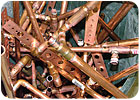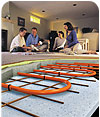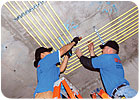Many Choices in Pipe Materials
There are plenty of choices available when a contractor or builder considers the materials to use when designing and installing plumbing systems in residential and commercial properties.
And among those options the clear choices often depend on the type of structure, the nature of the plumbing systems themselves and the codes that apply in that jurisdiction. Key attributes often include price, versatility, maintenance, performance, corrosion resistance and thermal conductivity. Following is a non-exhaustive look at the various materials used in pipe systems.

Copper tubing, one of the staples of the plumbing industry, has a long history of getting the water from place to place.
Copper
Copper pipe has been used for centuries to carry water, but its modern form of light and strong tubing has made it the leading choice for plumbing, heating, cooling and other mechanical systems. Copper tubing is used in water distribution systems, drainage and vent systems, underground water and gas services, heating systems, fuel oil systems, oxygen systems and non-flammable medical-gas systems.

While PEX can and is used for domestic water applications, its characteristics make it a natural for hydronic heating as well. Photo courtesy of IPEX.
The Copper Development Association in New York maintains that copper never requires painting for protection from corrosion and that after using copper a thin film forms inside the tube which provides a natural corrosion protection.
Copper pipe has a high thermal conductivity, conducting heat up to eight times better than other metals. It's used in solar energy systems where its thermal conductivity means that thinner copper sheet can collect the same heat as thicker-gauge sheets of steel or aluminum.
Andy Kireta Jr., CDA's national program manager said that while the cost of copper in 2006 put price pressure on everything made out of copper, including tubing and fittings, the Association expects the commodity price of copper to decline this year.
"Copper always has had historical swings in price," he said.
Kireta estimated that, in terms of new construction, copper has about 55 percent of the market. However, he pointed out that in commercial buildings, copper maintains market penetration of about 90 percent.
New methods of joining copper pipe in the past year or two, Kireta said, include the push-fit and press-fit methods of mechanical fittings. In push-fit, the end of a copper tube is reamed, a fitting is put on it and is pushed onto an "O" ring to make a seal. In the press-fit method, the fitting is slipped onto the copper pipe and a tool is used to crimp it over an "O" ring to make a seal.
"These fittings have really taken off in the past year," Kireta Jr. said. "They allow contractors to use less-skilled workers and the fittings mean contractors don't have to use a flame on the job."
Cross-Linked Polyethylene
Better known as "PEX," cross-linked polyethylene, results in a product that is durable under temperature extremes and chemical attack, and resists creep deformation, making it useable in hot water applications up to 200 degrees Fahrenheit.
Introduced into the United States in the 1980s from Europe, PEX is a flexible piping that makes it easy to install and service, according to the Plastic Pipe and Fittings Association. PEX is designed for indoor and underground service applications, it noted, so it can be used for underground cold water service applications, as well as in under-slab installations.
Chuck Waters, national sales manager of Ipex Inc. in Denver said his firm has seen a substantial increase in the use of PEX during the past year. Ipex makes a tubing called PEX-AL-PEX, a composite pipe that has an aluminum tube rolled and ultrasonically welded and then sandwiched between an interior and exterior PEX sheath.
"It's corrosion resistant and the aluminum gives stiffness to the pipe," Waters said. "We've seen great gains in its use, predominantly in our residential business, although the commercial market is growing too."
Waters added that Ipex also has a big market in hydronic heating where both composite PEX and standard PEX tubing are used. He said that his firm is introducing a new five-layer PEX that will have an oxygen barrier extruded in its core so it can't be scraped off by being dragged on the ground.
Kevin Clunie, business team manager for the plumbing and fire protection division of REHAU in Leesburg, Va., said his firm expects continued growth in the use of PEX for plumbing systems.
"The primary trend we've seen last year is the growing acceptance of PEX," he said, "We see that continuing for the foreseeable future."
John Bittenbender, technical engineering manager for REHAU, cited the price, ease of installation and maintenance of water quality as benefits offered by PEX: "Using PEX has become the norm now for a lot of the big homebuilders," he said.

Charlotte's ChemDrain CPVC is an economical alternative for the disposal of acids, bases, salts, and a wide range of organic media in institutional, academic, and commercial laboratories.
CPVC
Chlorinated Polyvinyl Chloride, called CPVC, is a thermoplastic pipe and fitting material used for potable water distribution, fire suppression systems and in corrosive fluid handling.
The CPVC pipe used in hot and cold water systems is resistant to many household chemicals and doesn't support combustion, which makes CPVC pipe attractive in fire sprinkler applications.
Brad Muller, vice president of marketing for Charlotte Pipe and Foundry in Charlotte, N.C., said his firm manufactures CPVC pipe for hot and cold water plumbing, as well as CPVC industrial Schedule 80 fittings. The firm also makes PVC and ABS pipe for drain, waste and vent plumbing, and cast iron pipe and fittings for residential and commercial applications.
"Residential construction has fallen off more dramatically in some markets, but the majority of our CPVC still goes into residential applications," he said. "However, we've seen a slowdown in that market."
In addition, he said, after Hurricanes Katrina and Rita, there was a shortage of piping material that caused price spikes, but that pricing has now returned to more normal levels.
"Because we make both CPVC and other plastics, as well as cast iron pipe, we're able to ride both sides of the construction industry and maintain our sales," Muller said.
Cast Iron
Cast iron soil pipe and its fittings are made from a process that involves a casting method where molten iron is poured into a mold that defines the shape of the finished product. The most common color of cast iron pipe, after it has cooled, is gray iron. Another type of cast iron is known as "ductile iron" and is produced by adding magnesium to the gray iron mixture in its molten state.
Bill Levan, executive vice president of the Cast Iron Soil Pipe Institute in Chattanooga, Tenn., said cast iron soil pipe is found in drain, waste and vent systems in both residential and commercial applications.
"You'll find it in drain and sanitary systems from a house to the street and in storm water systems for flat roofs, Levan said. "Cast iron soil pipe is used within the footprint of a building to between five feet outside a building to all the way to the street."
In addition, he noted, cast iron soil pipe is generally installed in commercial and industrial type buildings because of its longevity, resistance to corrosion, and the fact that it's non-combustible.
"There are installations of cast iron soil pipe in buildings that go back 100 years or more," Levan pointed out. "A lot of commercial kitchens use cast iron because their dishwashing machines typically discharge water at much higher temperatures than what you'd find in a residential setting."
Hospitals, hotels, dormitories and schools are some of the other applications using cast iron soil pipe, Levan said.
Gary Wickham, vice president of national sales for AB&I Foundry in Oakland, Calif., said all multiple family residential structures in California are required to be built with cast iron soil pipe.
"It's used in the drains, waste and vent lines because it's non-flammable, won't produce any fumes if there's a fire," Wickham said.
In addition, he added, cast iron soil pipe doesn't expand and contract like plastic pipe, which means there is no noise from the movement.
"In California, many homes are two stories and builders use cast iron to prevent noise between the floors," Wickham said. "Usually the stack and the vents going through the floors are cast iron and the vents going to the roof may be plastic. But the waste areas are cast iron to prevent noise."

Corrugated stainless steel tubing, or CSST, is one of the more quick and easy ways to save labor expenses on a job site when installing gas lines. Photo courtesy of OmegaFlex.
CSST
CSST stands for corrugated stainless steel tubing, an alternative to traditional black iron threaded gas piping used in industrial, commercial and residential applications. Proponents of CSST cite the tubing's flexibility, lighter weight, fewer connections and easy ability to be run around obstacles as the attributes that make it easier to install than black iron piping.
The tubing-a flexible, continuous stainless steel pipe with an exterior coating of PVC-is manufactured in coils and is air-tested for leaks.
According to the NAHB Research Center, about 45 million feet of CSST was installed in 2002, and more than 150 million feet has been installed in residential, industrial and commercial structures since 1989.
The Research Center also noted that depending on the setup, CSST can cost less than threaded black pipe and that because of fewer joints, there is less chance for a gas leak.
The Gas Research Institute said that labor savings from a quarter to two-thirds on new construction projects can be had, and nearly three-quarters on remodeling projects. The savings in labor may make up for the higher material cost of CSST, it added.
Bill Rich, director of codes and standards for Omega Flex Inc. in Exton, Pa., said that with the demand for new housing up high, more and more contractors are using CSST.
"In the hotter markets, many contractors have switched to CSST, even if they've not used it before," he pointed out.
CSST traditionally has been used in multi-family residential units and single-family homes, but Rich said that CSST is also moving into commercial applications.
"It's more of a specialty with commercial structures, like in Japanese hibachi restaurants, but as more codes start permitting it's use outside of residential structures, then it will increase on the commercial side."
The biggest trend, according to Rich, is in Las Vegas-style condominium buildings of 20 to 30 stories.
"More builders are using CSST in those types of structures because it goes in quickly and is easy to install," Rich noted. "Plus there are fewer joints, so there are fewer potential leak paths."
Rich added that with the cost of all metals rising, the extra cost of CSST has been reduced so there is no so much of a difference compared to black pipe.
"This article was originally posted on ww.reevesjournal.com."
Looking for a reprint of this article?
From high-res PDFs to custom plaques, order your copy today!






